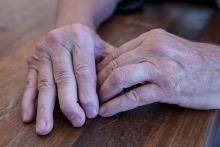PANLAR presented the first Pan American Guidelines for axial spondyloarthritis
In this video blog, Dr. Wilson Bautista explains the guidelines presented at PANLAR 2022 after research processes with a multidisciplinary group of specialists, as well as an analysis of what follows in the treatment and diagnosis process of this disease.
Hello everyone and welcome to a new Global Rheumatology video blog. We are here to speak specifically about the axial spondyloarthritis guidelines.
Welcome, Doctor.
WB: Thank you, Estefanía, and a very special greeting to the entire Global Rheumatology audience.
EF: Doctor, tell us, why are these Pan American guides necessary?
WB: The recommendations issued by PANLAR constitute a need, a broad need not only within the entire region, but specifically in Latin America. When we discuss the context of musculoskeletal and rheumatological diseases, it is evident that in the area of axial spondyloarthritis there is a serious need to have a set of guidelines and directives on how to offer adequate and comprehensive treatment in patients with axial spondyloarthritis.
So we have been working on this initiative for several years within the study group and raising awareness of the need at the regional level to work on a consensus document that would allow us to synthesize and conclude in the form of recommendations all those needs that we are faced with in different countries, especially in Latin America when we are dealing with a patient with axial spondyloarthritis.
So it was an initiative that appears within the study group and that gathers that feeling within the community of rheumatologists of having a position of a global academic society, as is the case of PANLAR and we know very well that we have international recommendations, ACR or EULAR, which are currently the ones which direct our clinical and therapeutic behaviors in these patients, and it is very interesting as well as necessary that we have some recommendations within our own context.
We know very well that the profile of our patients is different from what we can find in other regions of the world, and we also know that the contexts of health systems have variables that differentiate them between each country, and even between different regions. It is in this scenario that we materialize this need in the area of axial spondyloarthritis and we are now very close to the final phase of the publication of this set of recommendations, which we are going to group together in this sense, considering the opinion of rheumatologists from the different countries of the PANLAR community, which we believe and are certain will generate a very positive impact on both rheumatologists and on patients themselves and, of course, on the different health systems, which shall allow access and treatment of these patients.
EF: Precisely, how has the whole process of building these guides been and what novelties do they bring us?
WB: From the beginning we were clear that we wanted to develop a consensus document. This is how we brought together a group of almost 30 members within the developer panel, including rheumatologists, epidemiologists, there are also patients, and within that group we initially defined what the objective was that we wanted to achieve, defined the scope of application of those recommendations, and later we defined what those questions were, questions that we wanted to resolve and that reflected the scenario that we can find in clinical practice in the area when dealing with a patient with axial spondyloarthritis. So it was a bit of a daunting task to collect experiences, opinions and comments from the different countries where we know that there is a wide heterogeneity, not only in Latin America, but also in North America and we tried, in the sense of including all those aspects that we consider to be important to issue application recommendations at a continental level. What is new in this document? Well, what is new is 100% of the document, since they are the first recommendations issued by PANLAR. We know that several countries in Latin America have made efforts to have guidelines at the national level, but in that sense, axial spondyloarthritis would be the first recommendations.
So let's say that everything is new in that sense from the point of view of offering these guidelines and cover aspects not only of the objective of treatments always focused on remission of the disease, but also we talk about the images that are not required, that are not necessary for follow-up, only for diagnosis, but not repetitively or periodically for follow-up. In this sense, the role of non-steroidal anti-inflammatory drugs is positioned as the first initial treatment behavior in these patients, as well as other recommendations about the positioning of the different drugs or biological therapy, each one of them differentiated by mechanism of action, either antiTNF , intelectin 17, interleukin 23 Jack inhibitors, phosphodiesterase enzyme inhibitors .
And something very important that we also emphasize, Estefanía, in this recommendation, is the importance of this collaborative work. Integrating other specialties that also participate jointly in the management of these patients, such as the area of ophthalmology and the area also of physical medicine and rehabilitation, then integrating this multidisciplinary management and making a collaborative effort in the clinical setting is that we will be able to achieve that objective of controlling the disease in these patients, offering, of course, the best therapeutic strategies based on evidence.
EF: Precisely in this multidisciplinary scenario, what is the usefulness, the scope and to whom specifically are they directed or if it has a much broader spectrum considering all the professionals who were part of this process?
WB: Yes, Estefanía, of course within the scope of these recommendations and let's say the coverage we want to achieve, there is not only the community of rheumatologists who is like the spearhead or who leads the management of these patients, but also involves to other health professionals, especially physicians at the first level of care who, we know, constitute the entrance door, those who initially evaluate these patients with these symptoms and who subsequently refer them for evaluation by a rheumatologist. Likewise, we include all related specialties, mentioning ophthalmology, for example, orthopedics, dermatology, physical medicine and rehabilitation, the same specialty in internal medicine, family medicine, which constitute that group of health professionals who are involved in the follow-up of these patients over time.
Similarly, to patients. Patients are a fundamental part of this treatment process and this document included, or included the participation of a group of patients, who gave us their opinions, their point of view, and something very interesting, their perspective, which is practically a complementary point of view to what we as clinicians can offer in the management of these patients. And in general, the recommendations also have a very special audience, which is the entire administrative part of the different health systems. Including the decision makers and also for the different companies or the different insurance schemes that are the ones that participate in the policies and in the decision making, and that of course it is important that they know these guidelines and know these behaviors already in a consensus document so that they can facilitate this process of care and that comprehensive treatment that these patients require over time.
EF: With all that you have just told us about the wide range of people who will reach and who will even be from the front door, who are the doctors who initially attend, will this change and allow improvements in the diagnoses and treatments of this population?
WB: Estefanía, that is another of the objectives that we seek with this set of recommendations, we know that in axial spondyloarthritis there is a diagnostic delay between seven to nine years on average, and although in Latin America we do not have an estimate of this diagnostic delay, we could assume that it is something very similar to what the literature reports globally. So in that sense, reducing this gap of this diagnostic delay is constituted as a very clear objective on which we focus these recommendations and we achieve this in various ways, one of them is by raising awareness of the disease, that is, that all health professionals know it, that they have a greater knowledge or a basic knowledge about these symptoms the way to reach the diagnosis and, of course, the first lines of treatment that should be initiated in these patients, then this involves, even much beyond health professionals, including the administrative, regulatory part, at the level of each of the countries of the PANLAR community and, of course, the groups of patients who also constitute disseminators of this knowledge within what we call the general population that goes far beyond the direct doctor-patient relationship, and that of course this is part of what is called awareness, not only of axial spondyloarthritis, but also of other rheumatological diseases in which problems, access barriers, and difficulties are shared in the day-to-day scenario and that these academic efforts made in this case by PANLAR help and will help to contribute by providing knowledge, providing solutions, and of course accompanying the patients and accompanying the rheumatologists in this process of monitoring these patients.
EF: At this point of contribution of knowledge in research, how do we position ourselves with these guides, which are the first, compared to the global panorama of research and development in these aspects?
WB: Well, Estefania, interesting question. It is clear that in Latin America we are, let's say, a little behind in the research on musculoskeletal diseases, including, of course, axial spondyloarthritis and also psoriatic arthritis, but we think about it and we discuss this in the meetings with the developer group and with the members of the panel that these first management recommendations are going to be a first step to generate a research agenda, and this was one of the main conclusions of all the panel meetings, to generate those needs in the region in which we did not have enough evidence There was no support in the literature to answer these questions, and that raised the need for us to be able to generate this information within or in the context of our own patients and within the community of Latin American countries or even within PANLAR. So it constituted those questions that did not have a very broad support or evidence, a research agenda that we have developed and that we think about in the short and medium term, we speak here and in several years later, to be able to generate research projects, to be able to generate different initiatives at the regional level that allow us to learn more about the epidemiological behavior of axial spondyloarthritis in the region. Knowing, for example, the characteristics of images, the prevalence of extra-articular manifestations, the types of treatments, the main characteristics of patients who fail or do not respond to these treatments and something very important that we also discussed in those meetings was that we needed longitudinal follow-up studies that would evaluate not only adherence and persistence to treatment but also safety, adverse effects and that would allow us to know at the Latin American level what that photo is, what that impression is at the regional level of what the disease impacts at the level of patients and level of the different health systems.
So in that process of building recommendations, Estefanía, we solved a question, but three or four more were generated and that would give us a scenario in the short and medium term to answer it and I think that from the point of view of the study group and counting of course with the support of PANLAR, we hope in the coming years to have more research results in Latin America that contribute to that knowledge and allow us to generate much more information from the continent to share it globally.
EF: Doctor, thank you very much for this space, for this explanation and success in PANLAR 2022.
WB: Estefanía, thank you very much for these minutes, for allowing us to share about the socialization of these recommendations and, of course, it will always be a pleasure to be with this virtual audience, not only from PANLAR, but also from Global Rheumatology, which is an audience that has come growing in recent years and of course will continue to grow exponentially.







